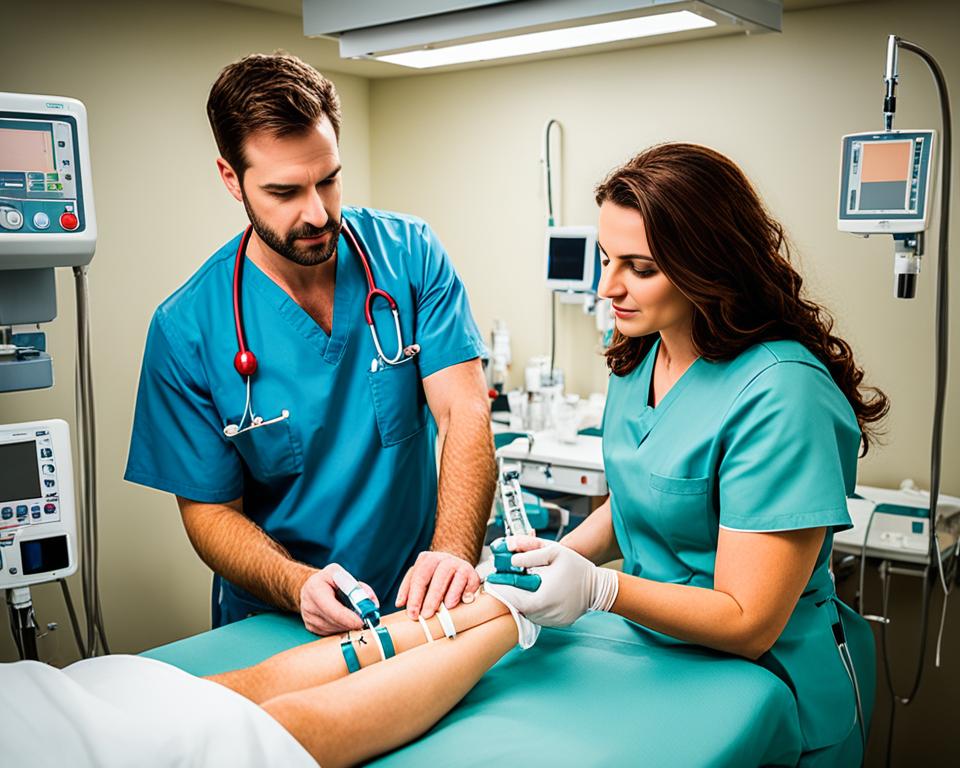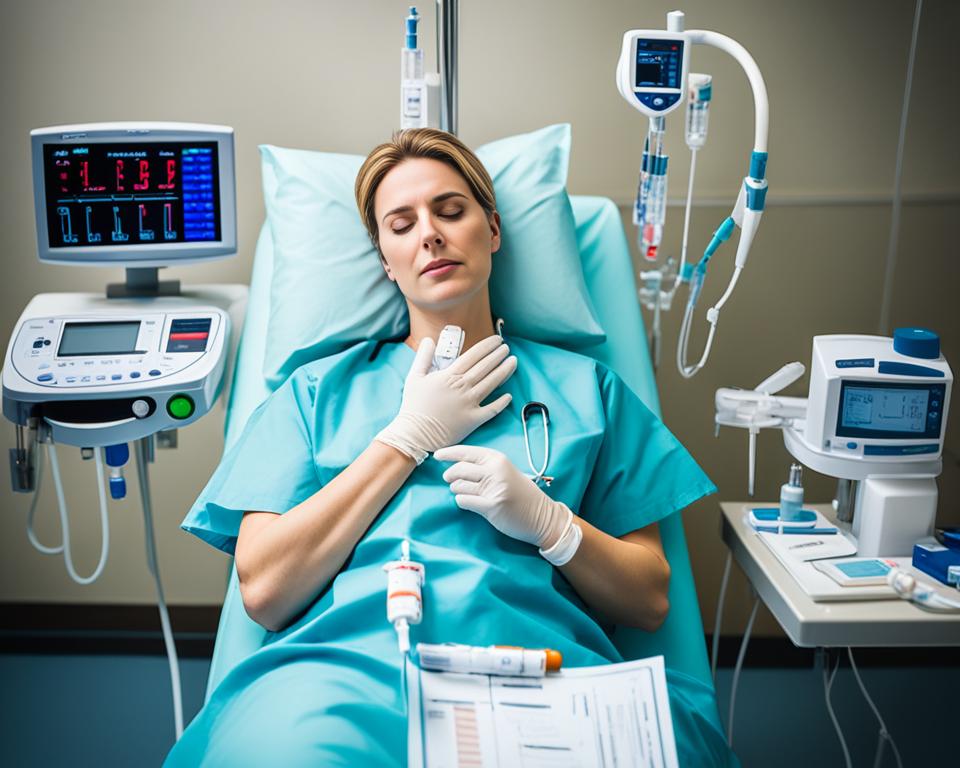Did you know that blood sugar levels exceeding 500 mg/dL can signal a medical emergency requiring immediate attention?
Uncontrolled blood sugar is considered dangerous, necessitating vigilant diabetes management. High blood sugar, or hyperglycemia, often manifests as excessive thirst, frequent urination, blurred vision, and heightened hunger. If your levels exceed 180 mg/dL after eating, your blood sugar is too high, while a reading below 70 mg/dL is concerningly low, potentially dropping to life-threatening levels below 40 mg/dL.
When dealing with severe hyperglycemia such as readings over 500 mg/dL, or symptoms indicating conditions like diabetic ketoacidosis or hyperosmolar hyperglycemic syndrome, it’s crucial to seek emergency care for high blood sugar at a hospital. Regular blood glucose monitoring and adherence to treatment plans are essential aspects of diabetes management to preclude crises such as diabetic comas and other severe complications.
An individual’s ability to maintain stable blood sugar levels is fundamental to avoiding severe hyperglycemia and consequent emergencies. Being proactive and attentive to hyperglycemia symptoms ensures timely intervention, safeguarding your health against the worst outcomes of uncontrolled blood sugar.
What Happens When Your Blood Sugar Is Over 500?

When your blood sugar levels exceed 500 mg/dL, you experience severe hyperglycemia, which poses significant health risks. This condition can lead to diabetic ketoacidosis (DKA), notably occurring in individuals with type 1 diabetes, as well as hyperosmolar hyperglycemic syndrome (HHS) in older adults or those with uncontrolled diabetes. Symptoms of high blood sugar include increased thirst, frequent urination, fatigue, and blurred vision. As hyperglycemia progresses, you may face severe complications such as confusion, dehydration, and even diabetic comas if left untreated.
Additionally, the long-term effects of high blood glucose complications can be profound. Persistent high blood sugar can lead to chronic conditions like cardiovascular disease, kidney damage, nerve damage, and vision impairment. Immediate symptoms of hyperglycemia, such as confusion and dehydration, must be addressed promptly to avoid the risk of diabetic coma, which is a life-threatening condition.
Monitoring your blood glucose levels consistently and managing your diabetes wisely are critical to preventing these severe complications. This involves regularly checking blood sugar as advised, taking prescribed medication, and following a structured healthcare plan. Understanding the symptoms of high blood sugar and acting swiftly can significantly mitigate diabetes health risks.
Should I Go to the Hospital if My Blood Sugar is Over 500?

If your blood sugar exceeds 500 mg/dL, it is critical to seek immediate medical assistance due to the significant health risks associated with such high levels. This can indicate a severe hyperglycemic state that demands urgent attention and intervention to avoid potentially life-threatening complications like diabetic ketoacidosis or hyperosmolar hyperglycemic syndrome.
Symptoms of Diabetic Ketoacidosis (DKA)
Diabetic ketoacidosis (DKA) often occurs when insulin levels are low, and blood sugar is high, causing the body to burn fat for energy, which produces harmful ketones. Key DKA symptoms include trouble breathing, vomiting, fatigue, muscle stiffness, extreme thirst, frequent urination, dry skin, fruity breath, and confusion. If your blood sugar level exceeds 240 mg/dL and these symptoms are present, testing for ketones is advised1. Without prompt diabetic ketoacidosis treatment, DKA can lead to fatal complications.
Symptoms of Hyperosmolar Hyperglycemic Syndrome (HHS)
Hyperosmolar Hyperglycemic Syndrome (HHS) distinguishes itself by extremely high blood sugar levels, typically 600 mg/dL or higher, leading to severe dehydration and thickened blood due to excess glucose being eliminated through urine1. Symptoms of HHS emergency include extreme thirst followed by a decrease in sensation, warm skin that remains dry, a fever over 101°F, confusion, no sweating, vision loss, weakness on one side of the body, and hallucinations. Recognizing these symptoms and seeking immediate medical care is crucial to prevent severe complications or death.
Emergency Treatments for Severe Hyperglycemia

Effective hyperglycemia management is vital in addressing life-threatening conditions such as diabetic ketoacidosis (DKA) and hyperosmolar hyperglycemic syndrome (HHS). Prompt emergency treatments can save lives and prevent serious complications.
Fluid Replacement
Intravenous fluid therapy is the initial step in treating severe hyperglycemia. Administering fluids helps to combat dehydration and reduce blood sugar concentration, providing immediate relief to the patient. By replenishing lost fluids, the body can begin to stabilize, ensuring crucial functions are maintained.
Electrolyte Replacement
Electrolyte management is the next critical step. High blood sugar levels can lead to frequent urination, causing essential electrolytes like potassium to become depleted. Replacing these electrolytes is crucial for maintaining proper muscle and nerve function, and overall stability of cellular functions.
Insulin Therapy
Insulin treatment for high blood sugar follows to lower glucose levels in the bloodstream effectively. Administering insulin helps the body to absorb glucose into cells, bringing blood sugar levels back to a safer range. Continuous monitoring of blood glucose and electrolytes is necessary throughout this process to ensure effective hyperglycemia management and to adjust treatment as needed for any underlying causes of the severe episode.
At-Home Monitoring and Prevention
Managing diabetes at home starts with consistent blood glucose monitoring. Utilizing a blood glucose meter or continuous glucose monitor allows you to regularly check your blood sugar levels and adhere to your healthcare provider’s plan when levels deviate from the target range. The American Diabetes Association recommends pre-meal blood sugar targets of 80-130 mg/dL and less than 180 mg/dL two hours post-meal. It’s crucial to stay vigilant about your readings and adjust treatments as needed to maintain optimal levels.
Medications, including insulin, should be taken precisely as prescribed. If your blood sugar levels remain within the target range for at least three months without the need for glucose-lowering medications, particularly in type 2 diabetes, it is considered in remission. Committing to a balanced diet and regular exercise helps enormously in maintaining these target levels and prevents severe hyperglycemia or other health crises.
Understanding the influence of various foods and activities on your blood glucose is essential. Diet and exercise play a pivotal role in blood sugar control, so knowing what elevates or lowers your levels enables better management. For hyperglycemia, managing carbohydrate intake, adding fiber, and staying hydrated can naturally lower blood sugar levels. Ensure you have a plan for sick days and communicate with loved ones about how to respond to emergencies. Wearing medical identification and keeping emergency glucose sources or glucagon kits handy can save lives during an unexpected diabetic emergency.
FAQs
Should I Go to the Hospital if My Blood Sugar is Over 500?
Yes, if your blood sugar levels exceed 500 mg/dL, it is considered a medical emergency. Immediate medical attention is required to prevent severe complications such as diabetic ketoacidosis (DKA) or hyperosmolar hyperglycemic syndrome (HHS). Visit the nearest emergency care center to manage the critical levels of hyperglycemia.
What Happens When Your Blood Sugar Is Over 500?
When your blood sugar is over 500 mg/dL, your body experiences severe hyperglycemia, leading to dehydration, confusion, and potential diabetic coma. Symptoms to look for include increased thirst, frequent urination, blurred vision, and extreme fatigue. Over time, this condition can cause significant health risks such as cardiovascular disease, kidney damage, and nerve damage.
What are the symptoms of Diabetic Ketoacidosis (DKA)?
Symptoms of Diabetic Ketoacidosis include trouble breathing, vomiting, fatigue, muscle stiffness, extreme thirst, frequent urination, dry skin, fruity breath, and confusion. It typically occurs when insulin levels are low, and ketones build up in the blood. If you experience these symptoms and your blood sugar exceeds 240 mg/dL, it is advised to test for ketones and seek immediate medical help.
What are the symptoms of Hyperosmolar Hyperglycemic Syndrome (HHS)?
Hyperosmolar Hyperglycemic Syndrome symptoms include extremely high blood sugar levels (600 mg/dL or higher), severe dehydration, warm skin that doesn’t sweat, fever over 101°F, confusion, weakness on one side of the body, vision loss, and hallucinations. HHS is an emergency condition, requiring prompt medical intervention to prevent severe complications.
What are the emergency treatments for severe hyperglycemia?
Emergency treatments for severe hyperglycemia include:
1. Fluid Replacement: Administering intravenous fluids to counteract dehydration and lower blood sugar concentration.
2. Electrolyte Replacement: Replenishing essential electrolytes such as potassium, which are typically lost through frequent urination and dehydration.
3. Insulin Therapy: Using insulin to gradually lower high blood sugar levels to safer ranges. Continuous monitoring of blood sugar and electrolytes is crucial during this process.
How can I monitor and prevent severe hyperglycemia at home?
Consistent at-home monitoring and preventative measures are key in avoiding severe hyperglycemia. You should regularly check your blood glucose levels using a blood glucose meter or continuous glucose monitor, and adhere to your healthcare provider’s plan. Take medications, including insulin, as prescribed, and adjust dosages based on your blood glucose readings. Diet and exercise also play critical roles; understanding how different foods and activities affect your blood sugar can help manage levels. Additionally, have a plan for sick days, recognize signs of blood sugar extremes, and educate loved ones on emergency procedures. Wearing medical identification and having emergency glucose sources or glucagon kits are essential for rapid response in case of emergencies.
